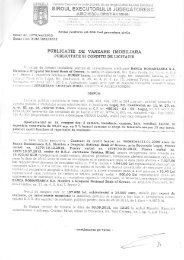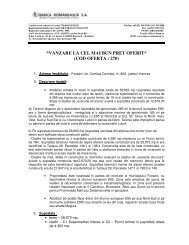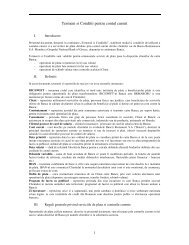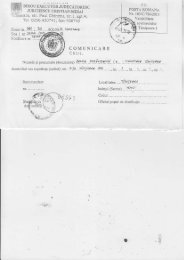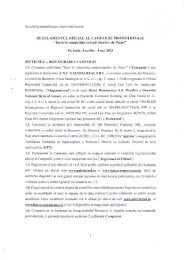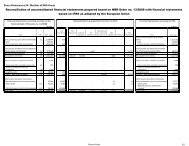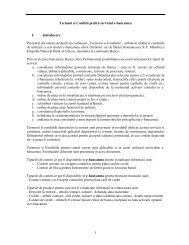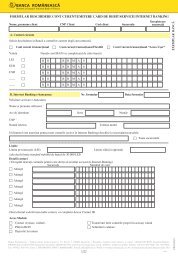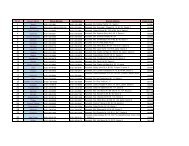Pillar III Disclosures - Banca Romaneasca
Pillar III Disclosures - Banca Romaneasca
Pillar III Disclosures - Banca Romaneasca
Create successful ePaper yourself
Turn your PDF publications into a flip-book with our unique Google optimized e-Paper software.
<strong>Pillar</strong> <strong>III</strong> <strong>Disclosures</strong><br />
31 December 2010
<strong>Banca</strong> <strong>Romaneasca</strong> SA<br />
<strong>Pillar</strong> <strong>III</strong> Report<br />
1. Regulatory vs accounting consolidation<br />
<strong>Banca</strong> <strong>Romaneasca</strong>, on individual level, draws up financial statements in accordance with Romanian Accounting<br />
Standards (RAS).<br />
<strong>Banca</strong> <strong>Romaneasca</strong> together with NBG Leasing IFN SA set up a factoring company, NBG Factoring Romania SA,<br />
incorporated in the last quarter of 2010, entity which is included in the consolidated financial statements of <strong>Banca</strong><br />
<strong>Romaneasca</strong> for December 2010. The factoring company is consolidated for prudential purposes in accordance<br />
with International Financial Reporting Standards (IFRS) using the global consolidation method, as <strong>Banca</strong><br />
<strong>Romaneasca</strong> has control over NBG Factoring Romania SA (99% of shares).<br />
2. REGULATORY OWN FUNDS AND CAPITAL ADEQUACY<br />
2.1 Own Funds’ structure<br />
Regulatory capital is classified under two main categories: Tier I and Tier II capital, according to the National<br />
Bank of Romania Regulation no. 18/23/2006 regarding own funds of credit institutions and investment firms.<br />
Tier I capital includes the Bank’s shareholders equity, net result, capital premium and eligible reserves. The<br />
following items are deducted from Tier I capital:<br />
- income tax and penalties for reserves. According to NBR Regulation no. 18/23/2006 the reserves have to<br />
be presented net of any tax obligation, foreseeable at the moment of computation of own funds 1) .<br />
- intangible assets;<br />
- non arm’s length transactions according to NBR Regulation no.18/23/2006.<br />
Tier II capital includes fixed assets revaluation reserve adjusted with the fiscal tax, foreseeable at the time of<br />
computation of own funds and the subordinated loan from National Bank of Greece.<br />
Regulatory Capital structure (RON)<br />
31.12.2010<br />
(individual level)<br />
31.12.2010<br />
(consolidated level)<br />
Total Regulatory Capital 1,026,174,639 1,147,893,769<br />
Tier I Capital 736,296,436 869,381,769<br />
Share capital 748,648,220 835,339,541<br />
Capital premium - -<br />
Net Result (72,228,780) (30,059,319)<br />
Reserves 111,730,378 128,606,151<br />
Credit Risk Reserve 34,761,674 34,761,674<br />
Legal Reserve 17,345,634 17,345,634<br />
Other Reserves 72,808,275 72,808,275<br />
Retained earnings - 3,690,568<br />
Profit distribution -<br />
Income tax & late penalties (13,185,205) (13,185,205)<br />
NBG Factoring participation (50%) individual<br />
level / minority interest consolidated level (990,000) 18,502<br />
Intangible assets (50,863,382) (51,337,901)<br />
Non arm’s length transactions - -<br />
Tier II Capital 289,878,203 278,512,000<br />
Fixed assets revaluation reserve 14,698,847 -<br />
NBG Factoring participation (50%) (990,000) -<br />
Income tax of fixed assets revaluation reserve (2,342,644) -<br />
Subordinated loan 278,512,000 278,512,000<br />
1) - taxes and late penalties for reserves are due if and when the initial destination of reserves is changed;<br />
- such taxes are deducted from tier 1, no matter if the bank does not have for the foreseeable future any intention to change<br />
the initial destination of reserves;<br />
- 2 -
<strong>Banca</strong> <strong>Romaneasca</strong> SA<br />
<strong>Pillar</strong> <strong>III</strong> Report<br />
2.2 Capital adequacy<br />
2.2.1 Capital requirements<br />
The table below presents the capital requirements of <strong>Banca</strong> <strong>Romaneasca</strong> as of 31.12.2010, in accordance with NBR<br />
Regulation no.13/18/2006 regarding minimum capital requirements. For credit risk the bank uses standardized<br />
approach according to NBR Regulation no.14/19/2006 on credit risk treatment, and for operational risk the basic<br />
indicator approach, in accordance with NBR Regulation 24/29/2006 regarding minimum capital requirements for<br />
operational risk. In case of market risk the bank computes capital requirements for foreign exchange risk, in<br />
accordance with NBR Regulation no. 22/27/2006 regarding capital adequacy of credit institutions and investment<br />
firms.<br />
RON<br />
Credit risk & Counterparty Credit Risk<br />
(Standardized Approach)<br />
Capital Requirements<br />
(individual level)<br />
Capital Requirements<br />
(consolidated level)<br />
Asset Class<br />
Central governments or central banks - -<br />
Regional governments or local authorities 741,761 729,912<br />
Administrative bodies and noncommercial undertakings - -<br />
Multilateral development banks - -<br />
International organizations - -<br />
Financial Institutions, out of which:<br />
- counterparty credit risk<br />
12,800,901<br />
3,017,854<br />
12,801,055<br />
3,017,854<br />
Corporate 95,383,785 94,264,267<br />
Retail 70,256,132 70,669,699<br />
Secured by real estate property 77,113,599 76,526,020<br />
Past due items 5,028,027 13,761,062<br />
Regulatory high-risk categories - -<br />
Covered bonds - -<br />
Short-term claims on institutions and corporate - -<br />
Collective investment undertakings - -<br />
Other assets 13,179,571 14,601,547<br />
Total Credit Risk & Counterparty Risk 274,503,776 283,353,562<br />
Market Risk - -<br />
Foreign exchange 4,004,571 2,415,474<br />
Operational Risk 58,264,008 59,551,481<br />
Total Capital Requirements 336,772,355 345,320,517<br />
Capital Adequacy Ratios Individual level Consolidated level<br />
Total Regulatory Capital 1,026,174,639 1,147,893,769<br />
Total Capital Requirements 336,772,355 345,320,517<br />
Total Capital Adequacy Ratio 24.38% 26.59%<br />
2.2.2 Internal Capital Adequacy Assessment Process (“ICAAP”)<br />
According to Basel II Capital Adequacy Framework, <strong>Pillar</strong> I sets the ways of measuring risks, especially credit,<br />
market and operational risks and aims to the alignment of the capital requirements with the risks undertaken.<br />
The above rules are complemented by <strong>Pillar</strong> II, which sets the requirements for monitoring, assessing and<br />
controlling all material risks to which credit institutions are exposed. Those requirements are associated with the<br />
Internal Capital Adequacy Assessment Process (ICAAP) applied by credit institutions.<br />
The Bank recognizes the importance of an effective Internal Capital Adequacy Assessment Process (ICAAP). The<br />
development and implementation of ICAAP aims at ensuring the adequacy of the credit institutions’ own funds for<br />
covering the various types of material risks which they are exposed to, as a result of their business activities.<br />
- 3 -
<strong>Banca</strong> <strong>Romaneasca</strong> SA<br />
<strong>Pillar</strong> <strong>III</strong> Report<br />
The ICAAP objectives are:<br />
• the proper identification, measurement, control and overall assessment of all material risks;<br />
• the development of the appropriate systems for the measurement and management of those risks;<br />
• the internal evaluation of the capital required for the mitigation of risks (“internal capital”).<br />
<strong>Banca</strong> <strong>Romaneasca</strong> has issued in 2010 the “Policy and Methodology for the Internal Capital Adequacy Assessment<br />
Process (ICAAP)” which was approved by the Executive Committee and Board of Directors. The bank proceeded<br />
to the implementation of ICAAP for the year 2010 by estimating the relevant internal capital for all major risk<br />
types. The ICAAP design briefly contains the following:<br />
• Risk profile assessment<br />
• Risk measurement and internal capital adequacy assessment<br />
• Stress testing development, analysis and evaluation<br />
• ICAAP reporting framework<br />
• ICAAP documentation<br />
<strong>Banca</strong> <strong>Romaneasca</strong> has recognized and analyzed under the ICAAP the following risks to which it is exposed,<br />
including also the risks addressed by regulatory capital (for which the capital requirement may be<br />
adjusted/differently approached): Credit risk and credit concentration risk, Operational risk, Market risk, Interest<br />
Rate Risk in the Banking Book (IRRBB), Liquidity risk, Country risk, Reputation risk, Model risk, Residual risk,<br />
Business risk, Strategic risk, Real estate risk, Regulation risk, Financial Investment risk, Capital access risk.<br />
<br />
Internal capital requirements are computed per each risk type, then summed up for all the risks and compared with<br />
the assessed internal capital. Calculations were based on the methodologies that have already been developed in the<br />
ICAAP Framework. Results showed that the bank has sufficient capital to cover the material risks that it is exposed<br />
to in its business activities, registering a comfortable level of the solvency ratio (22.31%), much higher than the<br />
regulatory limit or the limit established through the Significant Risks Strategy. Also, further to the estimation<br />
performed for 2011, it resulted that the bank will not be in need for additional funding, not even under the more<br />
prudent scenario.<br />
3. RISK MANAGEMENT FRAMEWORK<br />
The bank acknowledges the need for enhanced risk management and risk control and has established the Risk<br />
Management Unit to properly measure, analyze, manage and control the risks entailed in all its business activities.<br />
The main responsibilities of Risk Management Unit are:<br />
• In the area of risk management:<br />
o Ongoing risk monitoring and management of the lending portfolio;<br />
o Monitoring, evaluating risks undertaken by the business units and ensuring adequate risk<br />
management tools.<br />
• In the area of risk control, part of risk management function:<br />
o Ensure the compliance with risk policies, by taking into consideration all risks identified through<br />
the risk assessment process.<br />
The Risk Management Unit is headed by the Risk Executive Director, including the following structures, which<br />
address all types of risks: Corporate Credit Risk Division, Retail Credit Risk Division, Risk Control Division and<br />
Remedial Management Division.<br />
3.1 Credit Risk<br />
According to the bank’s Strategy for Significant Risks, the credit granting processes refers to:<br />
- Sound, well-defined credit-granting criteria based on the particular target market, the borrower or<br />
counterparty, as well as the purpose and structure of the credit and its source of repayment.<br />
- Credit limits that aggregate in a comparable and meaningful manner different types of exposures, at various<br />
levels: individual borrowers and counterparties, groups of connected borrowers and counterparties,<br />
industry limits, product limits<br />
- Clearly established procedures for approving new credits as well as the amendment, renewal and refinancing<br />
of existing credits.<br />
- 4 -
<strong>Banca</strong> <strong>Romaneasca</strong> SA<br />
<strong>Pillar</strong> <strong>III</strong> Report<br />
The Bank’s objective is to maintain appropriate on-going credit administration, measurement and monitoring<br />
processes, including in particular:<br />
- Sufficient and fully documented credit risk policies, ensuring consistency across the Bank and<br />
acknowledging key regulatory requirements.<br />
- Information systems and analytical techniques that enable measurement and monitoring of credit risk<br />
inherent in all relevant activities, providing adequate information/reports on the composition of the loan<br />
portfolio and its evolution, including identification of any specific risks (like for example concentration<br />
risk).<br />
The Bank follows adequate internal controls over the credit risk related processes, including:<br />
- Proper management of the credit-granting functions ensuring that credit exposures are within set limits.<br />
- Periodical early remedial actions on deteriorating credits, managing problem credits and similar workout<br />
situations.<br />
- Independent, ongoing assessment of the credit risk management processes by Internal Audit, covering in<br />
particular the credit risk systems/models employed by the Bank.<br />
3.1.1 Credit Policy for the Corporate Portfolio<br />
The bank’s Corporate Credit Policy serves to provide the employees with the fundamentals in managing credit risk<br />
in the Corporate Banking Portfolio regarding identification, measurement, approval, monitoring and reporting<br />
credit risk. The credit policy establishes the principles to be followed in the credit granting activity in order to<br />
ensure sound practices and a good quality corporate loan portfolio. The policy has been designed in accordance<br />
with the current best practice standards and in compliance with the regulatory framework in place. The control of<br />
the credit risk is performed in accordance with the provisions of the policy and in conjunction with the Lending<br />
Norm, the Risk Management Strategy for Significant Risks and other relevant procedures.<br />
3.1.2 Credit Policy for the Retail Portfolio<br />
The bank undertakes and manages retail credit risk, but the achievement of predetermined targets has to be<br />
corroborated with satisfying the clientele’s needs and maintaining simultaneously a healthy portfolio. The credit<br />
policy has a fundamental role in the achievement of this triple balance.<br />
The Credit Policy for the Retail Banking Portfolio sets the credit criteria, the policies and procedures which<br />
determine the framework for managing and minimizing the retail credit risks undertaken by the bank. The Policy<br />
serves to establish a common approach for managing retail banking risk and to set the framework for the basic<br />
credit criteria.<br />
The basic aim is to approach clients in accordance with the rules and the risk appetite of the Bank.<br />
3.2 Market Risk<br />
The most significant types of Market Risk to which the Bank is exposed are the following:<br />
• Interest Rate Risk<br />
• Foreign Exchange (FX) Risk<br />
Foreign Exchange Risk arises from the bank’s Open Currency Position (“OCP”). In order to ensure the correct<br />
estimation and the efficient management and monitoring of the Market Risk that derives from the bank’s activities,<br />
Risk Management Unit calculates on a daily basis the Value-at-Risk of the Open Currency Position. The bank<br />
performs spot, forward and foreign currency swap transactions. Transactions may be performed only with pre<br />
approved counterparties. The Open Currency Position Risk monitoring is assured through the observance of the<br />
regulatory limits imposed by NBR regulation as well as through internally defined limits.<br />
For monitoring the impact of the Interest Rate Risk, the bank produces periodically the Interest Rate Gap<br />
Report, which estimates the interest rate risk in the balance sheet.<br />
The market risk has been limited during 2010 as the bank has not been involved in trading activities. All the<br />
securities – treasury bills, certificates of deposit issued by NBR and bonds issued by the Romanian Government –<br />
are booked in the available for sale portfolio due to lack of any transaction activity and intention of transaction<br />
further to their acquisition on the primary or secondary market.<br />
- 5 -
<strong>Banca</strong> <strong>Romaneasca</strong> SA<br />
<strong>Pillar</strong> <strong>III</strong> Report<br />
3.3 Liquidity Risk<br />
For monitoring the impact of the liquidity risk, the bank employs the following methodologies:<br />
- Monitors Liquidity Gap Report<br />
- Monitors Large Providers of Funds<br />
The bank’s objective regarding the liquidity risk is to maintain an adequate liquidity level provided that the<br />
necessary sources are ensured to support the budget objectives. ALCO has the responsibility to monitor the<br />
liquidity of the bank and its evolution on each category of assets and liabilities.<br />
The Treasury Division has the responsibility to monitor and to assure the day to day liquidity of the bank’s<br />
operations.<br />
3.4 Operational Risk<br />
<strong>Banca</strong> <strong>Romaneasca</strong> has implemented the Operational Risk Management Framework, in order to address operational<br />
risks effectively and meet the requirements of regulatory compliance. Through this framework are applied four<br />
methodologies for monitoring the operational risk:<br />
− Risk and Controls Self Assessment (RCSA)<br />
− Key Risk Indicators (KRIs)<br />
− Loss Event Data Collection<br />
− Action Planning<br />
Risk Management Unit also reviews and monitors the bank’s operational risk profile on an ongoing basis,<br />
developing and implementing appropriate action plans with a view to ensuring that the necessary measures are in<br />
place for preventing or mitigating operational risks. The main responsibilities are: monitoring operational risk<br />
events, reporting to and updating the operational loss database, computing and reporting synthetic data to the<br />
management of the bank, monitoring and assessing the outsourced activities, testing and maintaining “Business<br />
Continuity and Crisis Management Framework Procedure”.<br />
For operational risk mitigation and in order to reduce the impact of operational loss, the bank has concluded two<br />
insurance policies, as follows:<br />
- Bankers Insurance and Electronic and Computer Crime Insurance<br />
- Directors and Officers’ Liability and Company Indemnity Policy<br />
3.5 Capital Adequacy<br />
In order to ensure the Bank’s compliance with the regulatory framework as well as to provide the Bank’s<br />
Management with consistent risk management information Risk Management Unit is responsible for reporting<br />
capital requirements and capital adequacy, large exposures (Regulation 16/21/2006 and further Regulation<br />
no.14/24/2010 regarding large exposures of credit institutions and investment firms).<br />
For the calculation of capital adequacy, a specialized software application is used, configured in order to calculate<br />
riskweighted assets according to the bank’s approach on each portfolio, in accordance with the current “Basel II”<br />
framework. Risk Management Unit submits regularly and consistently all the required reports to the National Bank<br />
of Romania.<br />
- 6 -
<strong>Banca</strong> <strong>Romaneasca</strong> SA<br />
<strong>Pillar</strong> <strong>III</strong> Report<br />
4. CREDIT RISK<br />
4.1 Definitions and general information<br />
For accounting purposes, “past due” exposures are those amounts which are past due for at least 1 day, other than<br />
those “impaired”. For accounting purposes, “impaired” exposures are those exposures for which regulatory<br />
provisions are computed and registered.<br />
4.2 Provisions calculation<br />
4.2.1 Credit risk provisions<br />
As of 2010, specific credit risk provisions were calculated in compliance with NBR Regulation no. 3/2009, as<br />
subsequently amended. For the computation of provisions, the loan portfolio is split into 5 categories of<br />
classification (Standard, Watch, Substandard, Doubtful and Loss) by applying simultaneously the following three<br />
criteria: debt service, financial performance/rating of the client (from A to E), initiation of legal procedures.<br />
If legal procedures have been initiated the loans are classified into the category Loss 2.<br />
If no legal procedures have been initiated, the loans are classified according to the matrix below:<br />
Financial<br />
performance A B C D E<br />
Debt service<br />
0 –15 days Standard In observation Substandard Doubtful Loss 1<br />
16 – 30 days In observation Substandard Doubtful Loss 1 Loss 1<br />
31 – 60 days Substandard Doubtful Loss 1 Loss 1 Loss 1<br />
61 – 90 days Doubtful Loss 1 Loss 1 Loss 1 Loss 1<br />
minimum 91 days Loss 2 Loss 2 Loss 2 Loss 2 Loss 2<br />
In case no legal procedures have been initiated and in case all amounts of that loan register a debt service of<br />
maximum 90 days, the gross exposures are diminished by related collaterals considered as deductible.<br />
In case legal procedures have been initiated or in case the client registers a debt service of more than 90 days (Loss<br />
2 category), the eligible collaterals to be deducted are adjusted by applying a 0.25 coefficient. The collaterals for<br />
the interest related to the above mentioned exposures are not taken into account, the coefficient applied having the<br />
value of zero.<br />
The net exposure resulted after the deduction of collaterals is provisioned with following percentages:<br />
Loan classification<br />
category<br />
Provisioning coefficient for loans (others than<br />
the loans denominated in foreign currency or<br />
indexed at the exchange rate of a foreign<br />
currency, granted to unhedged individuals*)<br />
Standard 0 0,07<br />
In observation 0,05 0,08<br />
Substandard 0,2 0,23<br />
Doubtful 0,5 0,53<br />
Loss 1 1<br />
Provisioning coefficient for loans<br />
denominated in foreign currency or indexed<br />
at the exchange rate of a foreign currency,<br />
granted to unhedged individuals*)<br />
4.2.2 T-bills & Bonds<br />
T-bills and the Bonds are classified depending on the initial intention in securities held for trading, securities<br />
available for sale (placements securities) and securities held until maturity. As per our current strategies,<br />
securities are held neither for trading and neither until maturity, being classified as available for sale<br />
securities. A fair value is calculated, using the traditional bond pricing (present value of future cash flows<br />
* The term „unhedged individual” means individual which does not generate positive net inflows denominated in the same currency with the<br />
loan, which would allow the reimbursement in time of each instalment (principal and interest).<br />
- 7 -
<strong>Banca</strong> <strong>Romaneasca</strong> SA<br />
<strong>Pillar</strong> <strong>III</strong> Report<br />
discounted using interest rates derived from firm/informative quotes from market makers), the securities portfolio<br />
being recognized at the smallest value between the purchase value and the fair value.<br />
The following tables present the analysis of the bank’s exposures by geographical region, by economic sector and<br />
by remaining maturity:<br />
Total gross exposures per asset classes before credit mitigation techniques<br />
RON Average for 2010 31.12.2010<br />
Asset Class<br />
Central governments or central banks* 1,779,184,406 1,686,226,621<br />
Regional governments or local authorities 1,254,086 0<br />
Administrative bodies and noncommercial<br />
- -<br />
undertakings<br />
Multilateral development banks - -<br />
International organizations - -<br />
Financial Institutions**, out of which:<br />
- counterparty credit risk<br />
384,797,766<br />
72,962,753<br />
293,708,491<br />
65,877,037<br />
Corporate (excl. past due) 1,715,833,102 1,584,186,351<br />
Retail (excl. past due and secured by<br />
1,683,713,027 1,748,228,574<br />
residential real estate property)<br />
Secured by residential real estate property 2,763,052,368 2,754,069,976<br />
(excl. past due)<br />
Past due items*** 381,051,779 474,817,014<br />
Regulatory high-risk categories - -<br />
Covered bonds - -<br />
Short-term claims on institutions and<br />
- -<br />
corporate<br />
Collective investment undertakings - -<br />
Other assets 393,055,842 393,882,383<br />
Total Gross Exposure 9,101,942,375 8,935,119,410<br />
* Includes T-bills and Bonds issued by the Romanian Government<br />
** Are included exposures to banks (nostro accounts, placements with other banks and counterparty credit risk)<br />
*** Past due items represent exposures which register more than 90 days pat due<br />
Total net* assets by remaining maturity<br />
RON Up to 1 1 to 3 3 to 12 1 to 5 years Over 5 years Total<br />
31.12.2010 month months months<br />
Total assets 1,579,286,978 277,009,168 424,903,461 1,085,940,870 4,292,113,310 7,659,253,787<br />
* Net assets are total gross assets from which are deducted provisions and amortizations<br />
Total loan portfolio, impaired exposures and past due amounts by economic sector<br />
2010<br />
RON<br />
Total loan<br />
portfolio*, out of<br />
which:<br />
Total outstanding<br />
(principal only)<br />
Impaired<br />
exposures**<br />
- 8 -<br />
Total<br />
Provisions<br />
Past due<br />
amounts***<br />
Total loan portfolio, out of which: 6,392,037,971 5,721,321,017 1,148,811,737 449,602,795 26,142,893<br />
Individuals 4,375,945,676 4,271,973,002 661,894,432 301,971,558 3,805,508<br />
Agriculture 41,259,825 30,209,771 1,455,241 372,569 50,104<br />
Manufacture of food, beverage and<br />
tobacco<br />
124,478,156 79,233,040 12,221,196 3,128,759 4,029,205<br />
Construction 248,848,111 104,665,156 48,779,815 16,913,830 2,646,803
<strong>Banca</strong> <strong>Romaneasca</strong> SA<br />
<strong>Pillar</strong> <strong>III</strong> Report<br />
Wholesale Trade 272,322,707 222,861,659 95,991,551 33,172,681 6,247,064<br />
Retail Trade 127,916,637 111,495,235 43,196,057 19,734,618 1,290,295<br />
Sales of Motor Vehicles 89,894,802 39,083,232 23,168,800 7,832,351 49,055<br />
Consumer & Mortgage Finance 26,569,903 26,562,817 - - -<br />
Local Public Administration 18,544,036 18,544,036 - - -<br />
Real Estate 162,486,019 127,995,308 35,712,315 23,362,675 249,326<br />
Leasing 147,935,854 119,953,251 108,208,083 4,671,622 -<br />
Manufacture of fabricated metal<br />
products, except machinery and<br />
60,255,114 50,987,338 35,677,676 3,478,925 5,271,468<br />
equipment<br />
Land transport; transport via<br />
pipelines<br />
32,737,387 31,043,957 16,808,285 2,400,952 317,602<br />
Manufacture of rubber and plastic<br />
products<br />
34,844,427 21,165,372 1,387,384 751,836 576,039<br />
Manufacture and storage of<br />
chemicals and chemical products<br />
4,607,970 4,290,901 4,496,110 3,338,143 -<br />
Hotels and restaurants 18,209,776 17,534,665 1,358,161 103,783 44,991<br />
Supporting and auxiliary transport<br />
activities; activities of travel<br />
6,988,149 6,276,178 2,581,381 1,834,781 12,976<br />
agencies<br />
Extraction of crude petroleum and<br />
natural gas; service activities related<br />
to oil and gas extraction, excluding<br />
194,393,787 76,086,957 - - -<br />
surveying<br />
Electricity, gas, steam and hot water<br />
supply<br />
49,929,106 49,365,637 - - -<br />
Others 353,870,529 311,993,505 55,875,250 26,533,711 1,552,456<br />
T-bills & Bonds 680,961,260 660,662,625 226,789,082 1,823,448 -<br />
TOTAL 7,072,999,231 6,381,983,642 1,375,600,819 451,426,243 26,142,893<br />
* Total loan portfolio comprises on balance sheet exposure, undrawn facilities and contingent exposure<br />
** Impaired exposures represent exposures for which provisions are registered (covering partially/entirely the exposure)<br />
*** Past due amounts represent amounts with at least 1 day of delay, but for which no provisions were registered. Past due exposures for<br />
which provisions were constituted are included in the impaired exposures.<br />
Geographical concentration of total loan portfolio, impaired exposures and past due amounts (excluding T-<br />
bills and Bonds)<br />
31.12.2010<br />
RON<br />
Total loan<br />
portfolio, out of<br />
which:<br />
Total outstanding<br />
(principal only)<br />
Impaired<br />
exposures<br />
Past due amounts<br />
BUCHAREST 2,912,293,416 2,361,112,965 539,198,762 11,276,298<br />
SOUTH-EAST 696,945,083 645,662,810 114,038,502 5,772,345<br />
NORTH-WEST 634,454,479 622,286,726 95,024,398 1,604,322<br />
CENTER 540,427,794 524,763,008 98,975,395 4,854,561<br />
WEST 401,470,639 388,535,330 76,086,905 360,152<br />
NORTH-EAST 490,022,992 477,666,913 85,344,134 1,384,858<br />
SOUTH 410,471,424 400,815,337 89,881,362 561,885<br />
SOUTH-WEST 305,952,144 300,477,928 50,262,279 328,473<br />
TOTAL 6,392,037,971 5,721,321,017 1,148,811,737 26,142,893<br />
- 9 -
<strong>Banca</strong> <strong>Romaneasca</strong> SA<br />
<strong>Pillar</strong> <strong>III</strong> Report<br />
Provision movement for credit risk (loan portfolio)<br />
RON 2010 2010<br />
Provisions for principal Provisions for interest<br />
Balance at 1 January 228,932,621 48,822,306<br />
Net expenses with provisions 128,617,281 40,147,358<br />
Loss from exchange rate differences 2,788,067 295,163<br />
Balance at 31 December 360,337,969 89,264,827<br />
4.3 Portfolio under the Standardized Approach<br />
The following External Credit Rating Institutions (“ECAI”) are used to risk weight exposures under the<br />
Standardized Approach:<br />
• Standard & Poor's<br />
• Moody's<br />
• Fitch<br />
The asset classes for which ECAI ratings are used are the following: Exposures to Central Governments and<br />
Central Banks and Exposures to Financial Institutions.<br />
The table below presents the exposure amounts, before and after credit risk mitigation, as of 31.12.2010, allocated<br />
to the credit quality steps.<br />
Exposures to Financial Institutions (RON mio)<br />
Credit quality step<br />
Exposure amount before<br />
Credit Risk mitigation<br />
Exposure amount after<br />
Credit Risk mitigation<br />
1 3.32 3.32<br />
2-3 30.86 30.86<br />
4-5 257.72 257.72<br />
6 - -<br />
Total 291.90 291.90<br />
4.4 Credit risk mitigation techniques<br />
In accordance with Regulation no.19/24/2006 regarding credit risk mitigation techniques, <strong>Banca</strong> <strong>Romaneasca</strong><br />
accepts the following instruments for mitigation of credit risk:<br />
- Unfunded credit protection (guarantees) from: central administrations and central banks, regional administrations<br />
and local authorities, credit institutions;<br />
- Funded credit protection: cash deposits, debt securities and material collaterals: residential and commercial real<br />
estate properties, other physical collaterals.<br />
4.4.1 Revaluation of material collaterals<br />
The estimation of the market value of the collaterals accepted by the bank is performed according to the<br />
stipulations of the “Guide for evaluation of collaterals on lending” issued by ANEVAR (Romanian National<br />
Valuators Association) and the provisions of International Financial Reporting Standards, in compliance with the<br />
requirements from NBR regulations (Regulation no.3/2009 and Regulation no.18/2009 with its further<br />
amendments).<br />
The estimation of the market value (equal to the fair value) of collaterals is performed periodically in order to:<br />
- deduct the collaterals value from the exposure within the computation of necessary credit risk provisions;<br />
- recognize the value of collaterals that can be taken into account as credit risk mitigation, when determining<br />
the risk weighted value of exposures, in order to compute the minimum capital requirements for credit risk.<br />
The values of the collaterals have to be monitored frequently as follows:<br />
- 10 -
<strong>Banca</strong> <strong>Romaneasca</strong> SA<br />
<strong>Pillar</strong> <strong>III</strong> Report<br />
a) in case of residential real estates the valuation has to be performed at least once at every three years and for<br />
the commercial real estates the valuation has to be performed once per year.<br />
In case that the evolution of the prices on the real estate market, according to the data disclosed by National<br />
Statistical Institute, reflect a decrease over 20%, end of year N versus end of year N-1, the bank will perform<br />
a new valuation of the real estate collaterals that have the previous evaluation older than 12 months.<br />
b) in case of tangible goods the valuation has to be performed at least once per year.<br />
In addition, valuation of collaterals may be necessary during the validity of the loan in certain specific cases (when<br />
are analyzed operations of replacing existing exposures or when are analyzed new operations having joint<br />
collaterals with other existing loans), according to Bank’s regulations in lending or/and valuation area and/or<br />
according to the necessities resulted in the process of analysis/approval/monitoring process of the bank’s<br />
exposures.<br />
The valuation of collaterals is performed by external valuators or internal valuators of the bank, members of<br />
ANEVAR (Romanian National Valuators Association).<br />
Total exposure covered by cash collateral deposits and guarantees received from banks and local public<br />
administration (RON) as of 31.12.2010<br />
Cash collateral deposits<br />
Exposure class (Eligible financial<br />
collateral)<br />
Guarantees received<br />
from banks / central<br />
government / local<br />
public administration<br />
(eligible guarantees)<br />
Corporate 56,684,203 37,716,748<br />
Retail 26,025,409 429,731,835<br />
Past due items 2,005,286 -<br />
Total 84,714,898 467,448,583<br />
The rest of the exposures are covered by other types of collaterals.<br />
5. COUNTERPARTY CREDIT RISK<br />
For the efficient management of counterparty risk, the Bank has established a framework of counterparty limits.<br />
The list with counterparties is maintained and updated by the Risk Management Unit. For the implementation of<br />
new limits to counterparties or the increase of the existing limits, the endorsement of the NBG Risk Management<br />
Division is required. The monitoring of the limits is performed by the Risk Management Unit which also reports in<br />
this respect to the management of the bank and to NBG Risk Management Division.<br />
Counterparty limits are set based on the credit rating of the financial institutions. The credit ratings are provided by<br />
well-known external ratings assessment institutions and more specifically by Moody’s, Standard & Poor’s and<br />
Fitch. The limits framework is revised according to the business needs of the bank and the prevailing conditions in<br />
the financial markets.<br />
For capital requirements calculation purposes the bank calculates the exposure amount of derivatives by applying<br />
the Mark-to-Market (“MTM”) methodology (NBR Regulation no. 20/25/2006). The exposure value is represented<br />
by the sum of current replacement cost and the potential future credit exposure. As of 31.12.2010 the bank’s<br />
exposure at risk computed for OTC derivatives exposures subject to counterparty credit risk is in amount of RON<br />
65,877,037. The above mentioned derivatives represent forward foreign exchange and interest rate swap contracts:<br />
31.12.2010<br />
RON<br />
Forward foreign<br />
exchange contracts<br />
Exposure value RWA Capital<br />
requirements<br />
65,877,037 37,723,178 3,017,854<br />
- 11 -
<strong>Banca</strong> <strong>Romaneasca</strong> SA<br />
<strong>Pillar</strong> <strong>III</strong> Report<br />
6. MARKET RISK<br />
<strong>Banca</strong> <strong>Romaneasca</strong> does not have a Trading Book currently in place. Consequently, the Bank does not calculate<br />
capital charges against the market risk of the Trading Book. The only market risk related capital charges are the<br />
ones for the open currency position which are calculated according to NBR Regulation no. 22/27/2006 regarding<br />
capital adequacy of credit institutions and investment firms. As of 31.12.2010 the market risk capital requirements<br />
for foreign exchange risk is RON 4,004,571.<br />
The Bank uses the Value-at Risk methodology for monitoring the foreign exchange risk. The VaR estimates are<br />
used internally, as a risk management tool. The bank’s Risk Management Unit calculates on a daily basis the VaR<br />
of the Bank’s Open Currency Position, using a 99% confidence interval and 1-day or 10-day holding periods. The<br />
calculation of the VaR relies on the assumption that the returns on individual risk factors (exchange rates) follow a<br />
normal distribution.<br />
7. EQUITY EXPOSURES NOT INCLUDED IN THE TRADING BOOK<br />
Investments in shares that are not included in the trading portfolio are included in the available for sale portfolio.<br />
The available for sale investments in shares are recognized at fair value, as follows:<br />
Security Issuer Currency Acquisition Cost Fair Value<br />
Shares SNCDDVM RON 2,460 2,460<br />
Shares RI Monitor RON 10,000 10,000<br />
Shares Transfond S.A. RON 472,096 472,096<br />
Shares Biroul de Credit RON 324,740 324,740<br />
Shares Master Card International USD 9,629 9,629<br />
Shares SWIFT EUR 21,440 21,440<br />
Shares NBG Leasing RON 1,800 1,800<br />
Shares NBG Factoring RON 1,980,000 1,980,000<br />
8. INTEREST RATE RISK IN THE BANKING BOOK<br />
For monitoring and reporting the potential interest rate risk impact, Risk Management Unit has the responsibility<br />
of producing the Interest Rate Gap Report. The report estimates the interest rate risk for the entire balance sheet<br />
both from an earnings perspective (unrealized gain/loss in the event of a yield curve shift across time buckets for<br />
every meaningful currency in the balance sheet) and from a valuation perspective (Economic Value of Equity).<br />
The Earnings at Risk Indicator for each time bucket is calculated by applying the shift in the yield curve for each<br />
time bucket.<br />
For measuring the Earnings at Risk indicator under normal conditions the following upward / downward shift in the<br />
yield curve assumptions are used: RON – 200 bps, EUR and other currencies – 50 bps, USD – 100 bps. The<br />
Earnings at Risk Indicator is calculated for the up-to-1 year interval and for the entire balance sheet, excluding any<br />
Trading positions.<br />
For measuring the Earnings at Risk indicator under stress conditions the following upward / downward shift in the<br />
yield curve assumptions are used: RON – 400 bps, EUR and other currencies – 200 bps<br />
- 12 -
<strong>Banca</strong> <strong>Romaneasca</strong> SA<br />
<strong>Pillar</strong> <strong>III</strong> Report<br />
Please find below the computation as of 31.12.2010 for EaR indicator:<br />
Normal conditions<br />
Stress Conditions<br />
Adjusted Earnings at Risk Total Balance<br />
Total Balance<br />
(RON)<br />
Sheet<br />
12 Months Sheet<br />
12 Months<br />
± 20,198,486 ±19,787,919 ± 40,396,972 ±39,575,839<br />
The change in the Economic Value of Equity is calculated based on the methodology provided by the National<br />
Bank of Romania in Regulation 18/2009. It assumes a parallel shift (up and down) of 200 bps in interest rates for<br />
all maturities.<br />
As of 31.12.2010 the change in the Economic Value stands at +1.59% of the Bank’s Own Funds assuming a<br />
downward move in interest rates and -1.59% of the Bank’s Own Funds assuming an upward move in interest rates.<br />
- 13 -


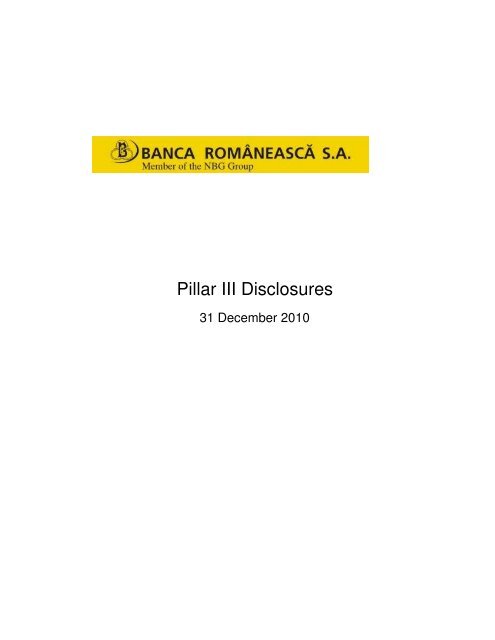
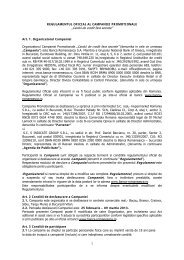

![L: t] tr *&T* $q ffi gTf e$ **'AT I - Banca Romaneasca](https://img.yumpu.com/42278608/1/184x260/l-t-tr-t-q-ffi-gtf-e-at-i-banca-romaneasca.jpg?quality=85)
